Fall IDF 2005 - Day 1: Coverage of Everything
by Anand Lal Shimpi on August 24, 2005 2:31 AM EST- Posted in
- Trade Shows
Although this morning was made interesting by the rush of a new microprocessor architecture, the second keynote of the day was far less engaging - albeit concerning a very important topic: mobility.
Intel had a quick slide up about Napa, the platform for Yonah in the first half of next year:
There's not much new here, but Napa did end up occupying a few more minutes of the keynote. Intel was proud to announce that the development and design wins of Napa are proceeding at a better rate than Sonoma, the current Centrino platform.
Obviously, Napa and Yonah are still about half a year away from their release (Intel has indicated that they will ship in the first quarter of next year), so we'll have to wait until next year to see how quickly Intel truly moves to Napa.
One thing that we found very interesting is that Napa also appears to be the platform of choice for Merom. In fact, Intel's platform for Merom is listed in their literature as either being Napa or a Napa Refresh, not a brand new design. We are hoping this means that Merom will work in Yonah motherboards, also hopefully meaning that Conroe will work in the next-generation Pentium D motherboards. The wish is that if you were to buy an Intel motherboard early next year, that you'd be able to use a next-generation CPU in it. While it is far from Intel's style to do so, so far the indications of such a scenario being possible are looking quite good.
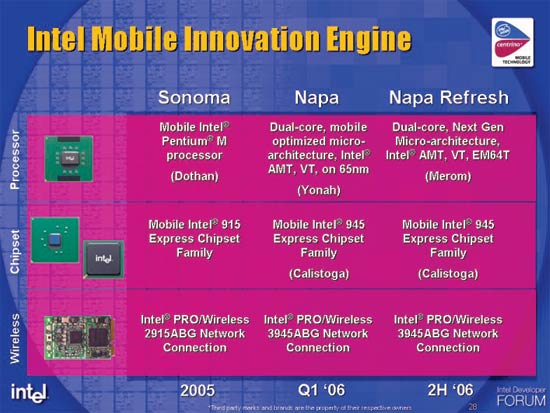
Intel indicated that they would supply design guidelines to motherboard makers early in 2006 so that their early '06 platforms could potentially support the new processors released in the second half of 2006. Maybe Intel has indeed learned from AMD when it comes to backwards compatibility, or then again maybe we're reading far too into this and we are hoping for more than reality.
Intel also demoed a 1.2GHz Xscale CPU, although they didn't commit to shipping it at 1.2GHz, this demo was more of a proof of concept.
Intel talked about their partnership with Panasonic in developing new notebook batteries which should help them meet their 8-hour battery life in 2008 goal.
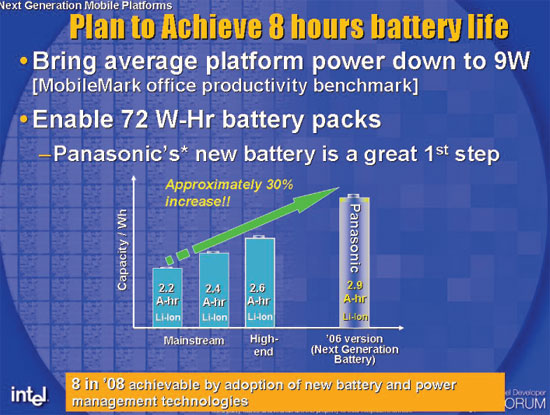


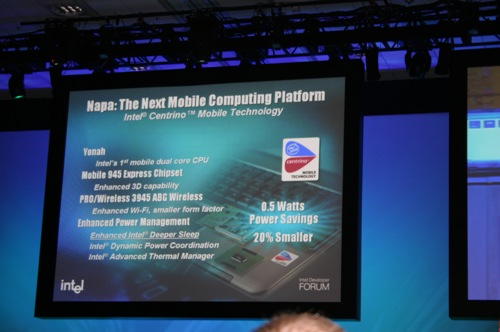
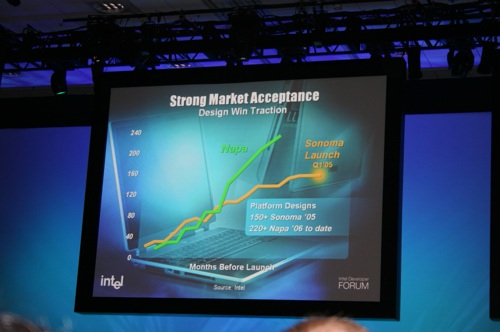
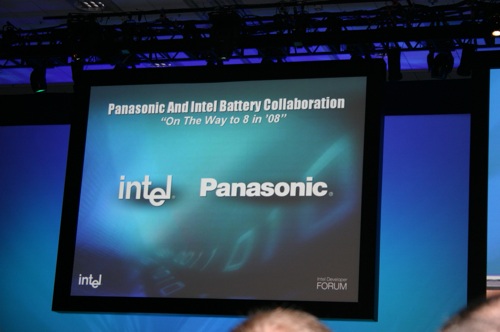
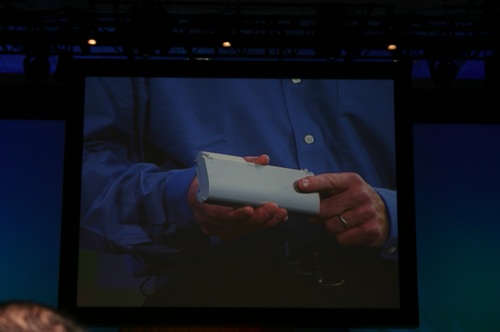








14 Comments
View All Comments
jediknight - Wednesday, August 24, 2005 - link
What encryption algorithm does the Seagate drive use? And is it firmware-upgradeable?smn198 - Thursday, August 25, 2005 - link
I'd like moredetails on this. If you've got an OS installed and no key yet, could you then add a key and have it re-encrypt the data or would you need to pull the disk out and do this from another system? Shame Seagate won't ship software. Is there anything free?missleman - Wednesday, August 24, 2005 - link
BONZI BUDDY?!?!?! WTF? I cant beleive intel was stupid enough to install that on their computers.JarredWalton - Wednesday, August 24, 2005 - link
Maybe it was a demonstration of malware getting installed on one virtual OS, and then another OS could detect it and remove it? I know Intel has talked about using virtualization for virus-related stuff before, so it's not too much of a stretch.Hacp - Wednesday, August 24, 2005 - link
Also nice to see the Xbox360... I'm not gonna buy one.xsilver - Wednesday, August 24, 2005 - link
is amd moving to ddr2 and then m2 sockets in a 2 stage process?if so that's pretty evil -- makes users upgrade twice
JarredWalton - Wednesday, August 24, 2005 - link
No, M2 is DDR2 for desktops. S1 is DDR2 for the mobile sectore. F is for the server/workstation market. All are DDR2-only solutions, and there will be no DDR2 support without a socket transition.IamTHEsnake - Wednesday, August 24, 2005 - link
Mitosis looks promising indeed.It's technologies like this that intrigue me. This is more of what Intel should focus on, not just the brute computational strength of mhz or pipeline stages.
I am also looking forward to hearing more about die-stacking and DRAM-on-die.
Furen - Wednesday, August 24, 2005 - link
Yes, mitosis sounds nice indeed (though I'd expect it to be worthless on tasks like gaming), hopefully the software overhead wont be too bad by the time we start seeing it.phaxmohdem - Wednesday, August 24, 2005 - link
One has to wonder in Re: to Mitosis...They say that it is just started in Research and Development, and that we may not see if for 5-10 years..... By then wouldn't all apps be written to take advantage of multithreading? Thus rendering Mitosis a day late and a dollar short?